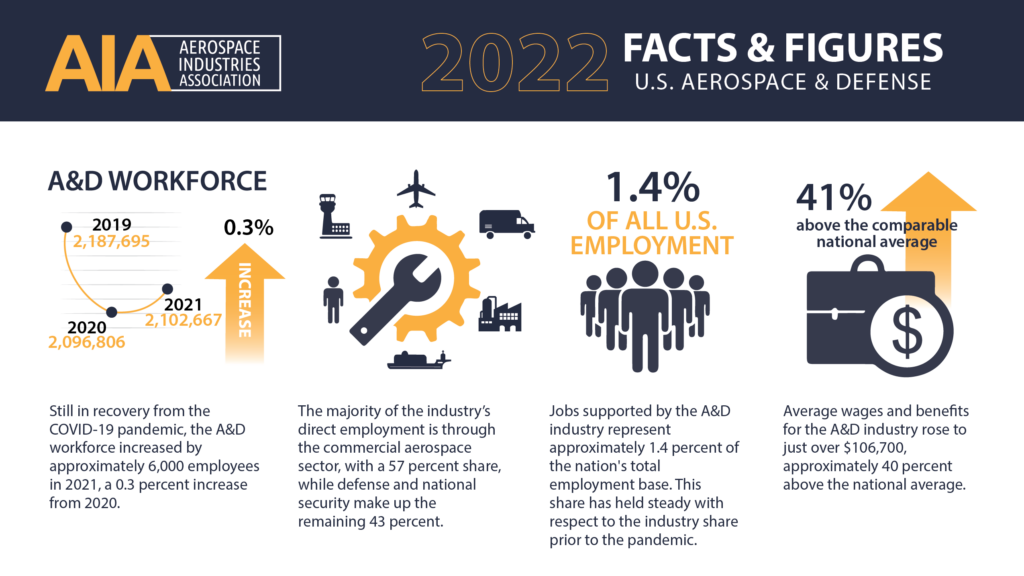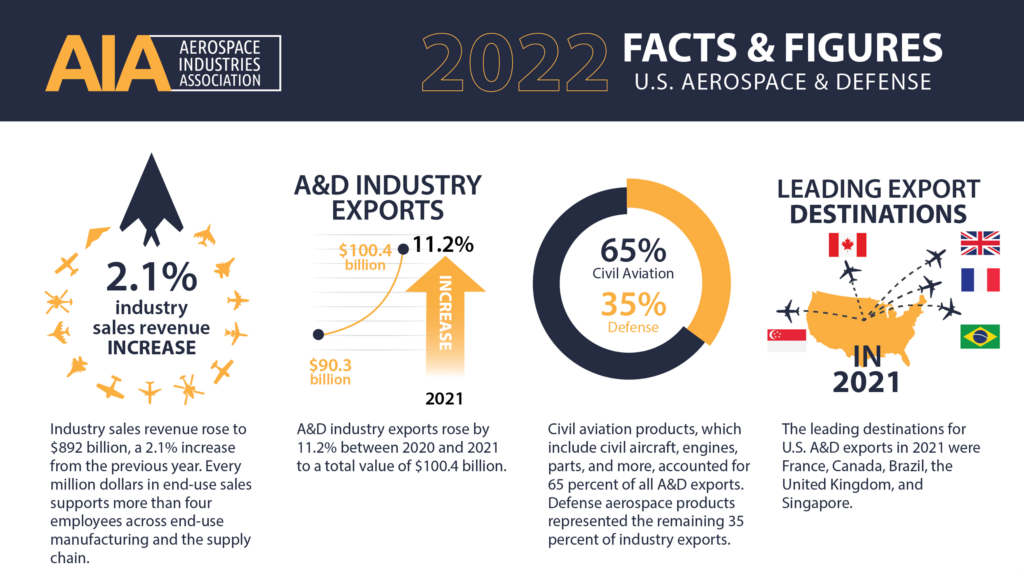U.S. aerospace and defense industry remains enduring asset despite continued pandemic recovery, inflationary pressures
Arlington, Va. – The Aerospace Industries Association (AIA) in collaboration with IHS Markit today released “Facts & Figures,” a look into the state of the A&D industry as it continues to navigate economic, legislative, and regulatory challenges while investing in its workforce, generating economic growth, advancing innovation, and enabling national security. Informed by 2021 data, “Facts and Figures” is a snapshot of the A&D industry’s workforce, wages, sales, and trade numbers.
“The American aerospace and defense industry and its workforce are strategic assets that no other country has to offer. This year’s ‘Facts and Figures’ data provides a glimpse into how the industry continues to recover from the pandemic, work through economic hurdles, and capitalize on our world-class workforce and enduring spirit of innovation,” said Eric Fanning, President and CEO of AIA. “Despite the challenges we face, we are proud of our role in connecting the world through air travel, exploring new frontiers, and defending what matters most.”

At the heart of the A&D industry is its workforce, powering the recovery of air travel, designing more sustainable aviation technologies, providing cutting-edge defense and deterrence capabilities, and developing the systems that will further space exploration. Even when facing challenges, the 2021 A&D workforce stood at more than 2.1 million strong, with employees in every state in the U.S. These are highly skilled, good-paying jobs, with an average salary of over $106,700, about 40 percent above the national average.
Jobs supported by the A&D industry represent approximately 1.4 percent of the nation’s total employment base. Although still in recovery, the A&D workforce increased by approximately 6,000 employees. More than 57 percent of employment comes from the shared A&D supply chain, an extensive network of suppliers composed of thousands of small and medium-sized businesses.
Despite the inflationary pressure and continued pandemic recovery, the industry’s workforce generated $892 billion in combined sales in 2021, a 2.1 percent increase from the prior year. That is promising news for America, as every million dollars in end-use sales supports more than four employees across end-use manufacturing and the supply chain.

A key component to workforce success is industry’s global leadership in innovation and exports of aircraft and aerospace products. In 2021, A&D industry exports rose by 11.2 percent to a total value of $100.4 billion. From sustainable aviation technologies to defense systems, partners around the world trust American companies to provide the best capabilities at the best value. In 2021, the U.S. A&D industry exported to 205 countries, a testament to industry’s role in America’s economic success and reputation as a global leader in innovation.
In the U.S. and abroad, there is strong, bipartisan support for increased defense investment, which helps the shared A&D supply chain. With inflation running at more than double the rate anticipated when most contracts were negotiated, companies have limited tools at their disposal to manage increasing costs and maintain their workforce and may choose to leave the defense industrial base entirely. The result would be significant harm to national security, global competitiveness, and our ability to surge to meet demand of our partners and allies.
“As we look ahead to 2023, AIA and its members are ready to meet the moment, work with our government partners, and ensure the aerospace and defense industry continues to fulfill its vital role as one of America’s enduring advantages,” Fanning continued.
Find more information on Facts and Figures, including video and graphic resources, here.
Facts and Figures Data, collected for 2021 calendar year:
- In 2021, the U.S. A&D industry had more than 2.1 million in the workforce, with employees in every U.S. state.
- The A&D workforce increased by approximately 6,000 employees in 2021, a 0.3 percent increase from 2020.
- The majority of the industry’s direct employment is through the commercial aerospace sector, with a 57 percent share, while defense and national security make up the remaining 43 percent.
- Across the four subsectors of the A&D industry, aeronautics and aircraft is the largest employer, directly supporting almost 575 thousand jobs. The land and sea systems subsector is the next largest with about 148 thousand workers. Another 79 thousand workers represent the space subsector, while about 89 thousand are employed in the cyber subsector.
- Jobs supported by the A&D industry represent approximately 1.4 percent of the nation’s total employment base. This share has held steady with respect to the industry share prior to the pandemic.
- More than 57 percent of employment comes from the shared A&D supply chain.
- Last year, industry sales revenue rose to $892 billion in economic output, a 2.1 percent increase.
- Every million dollars in end-use sales supports more than four employees across end-use manufacturing and the supply chain.
- The A&D industry generated $391 billion in economic value, which represented 1.7 percent of total nominal GDP in the US.
- The $224 billion in labor income supported by the A&D industry represented 1.8 percent of the nation’s total labor income.
- Between 2020 and 2021, A&D industry exports rose by 11.2 percent to a total value of $100.4 billion.
- The U.S. A&D industry exported to 205 countries in 2021.
- The A&D industry generated $391 billion in economic value, which represented 1.7 percent of total nominal GDP in the US.
- The average labor income per job within the A&D industry amounted to just over $106,700, or approximately 40 percent above the national average, reflecting the highly skilled nature of the workforce.
###

